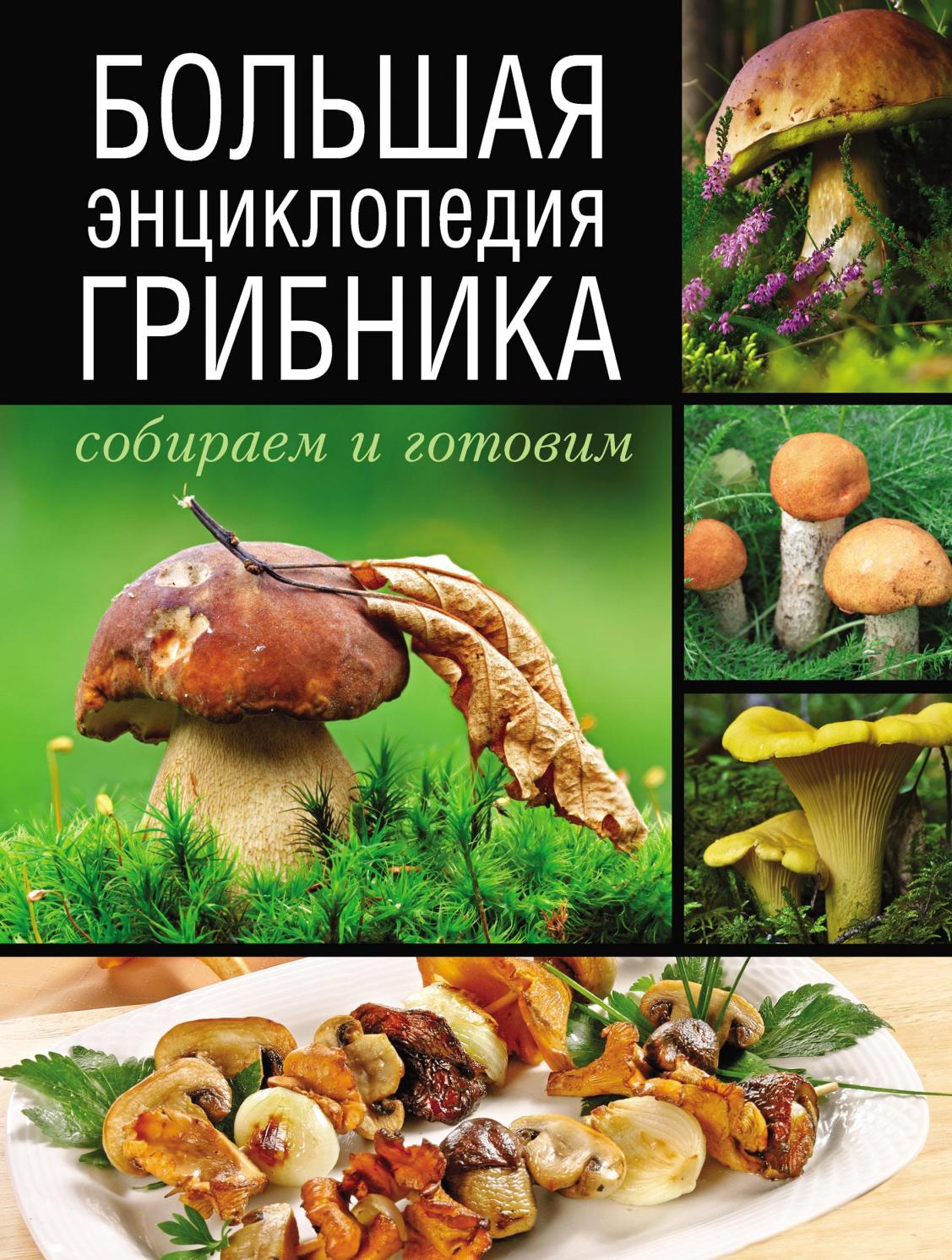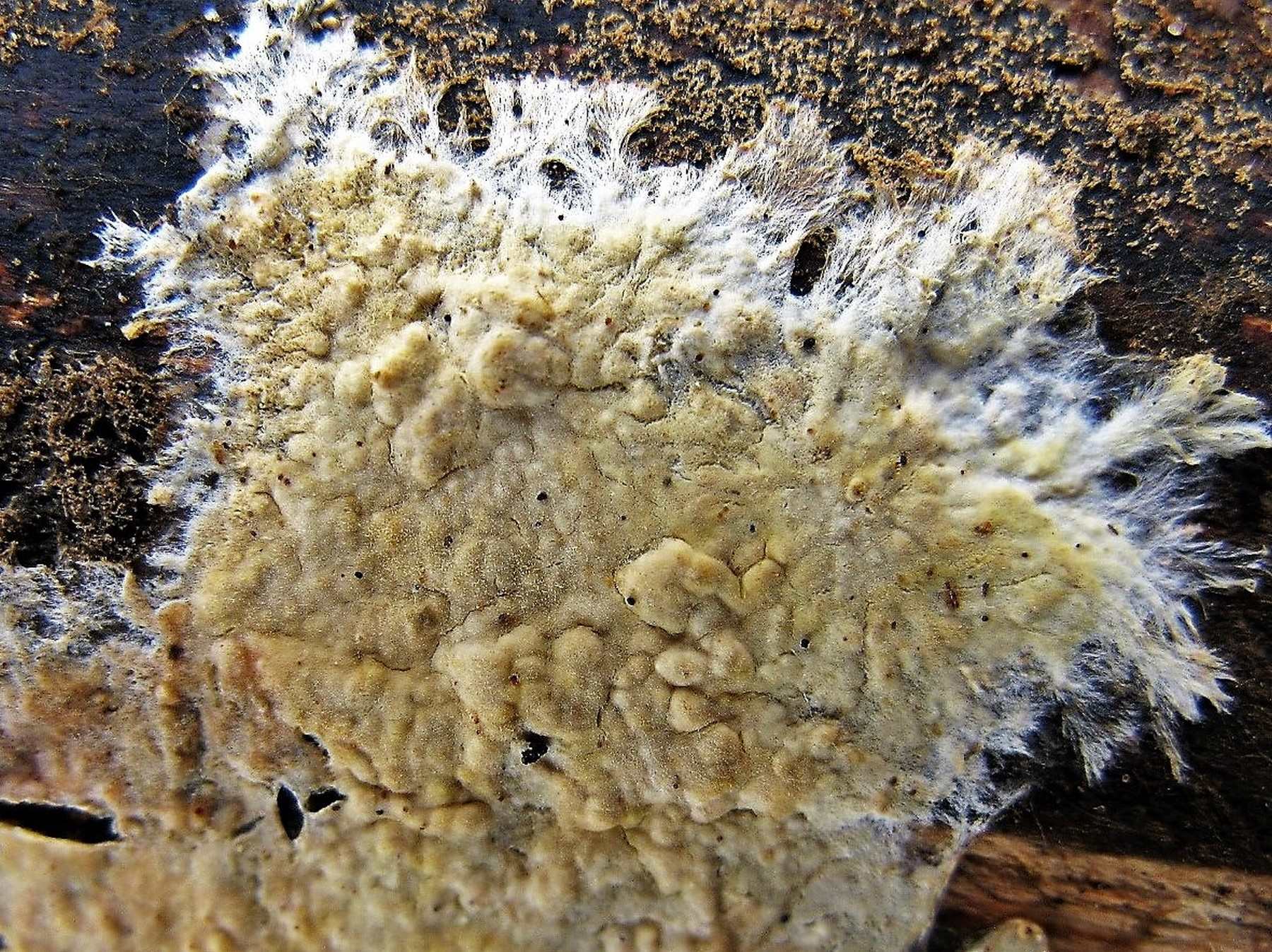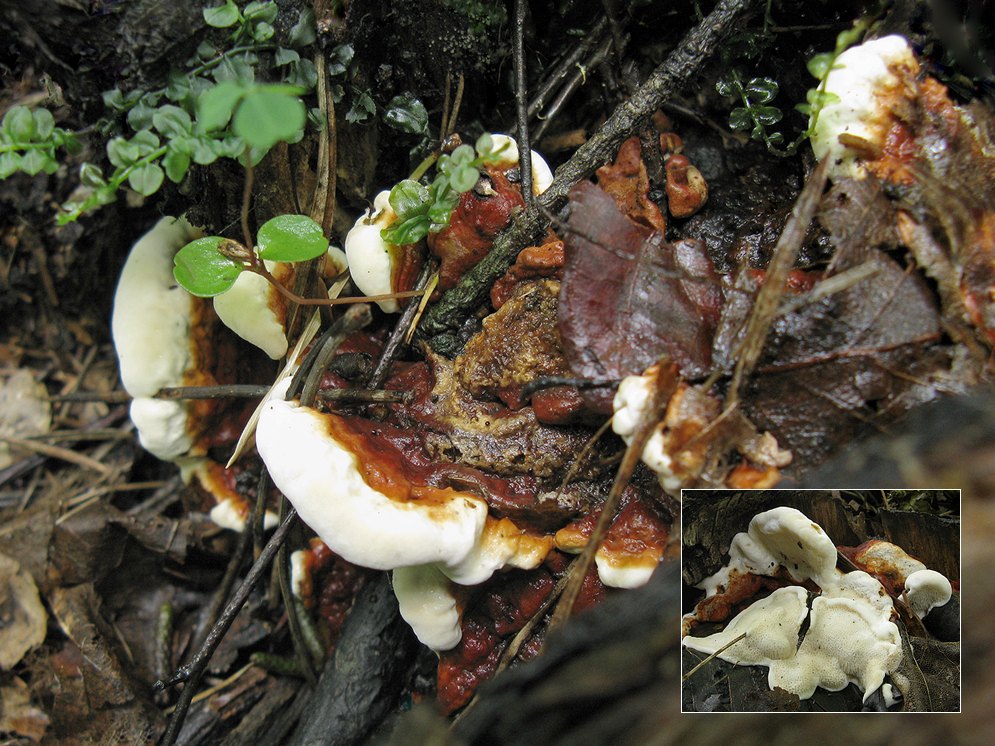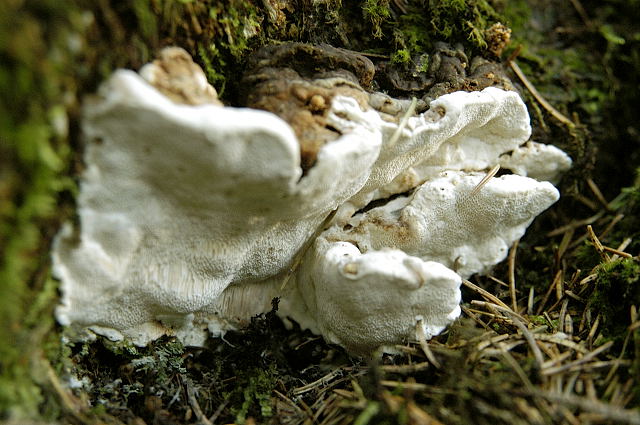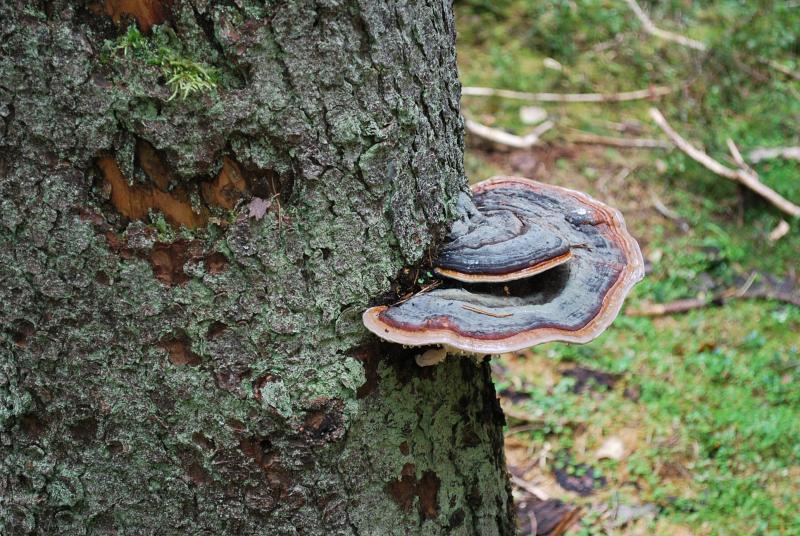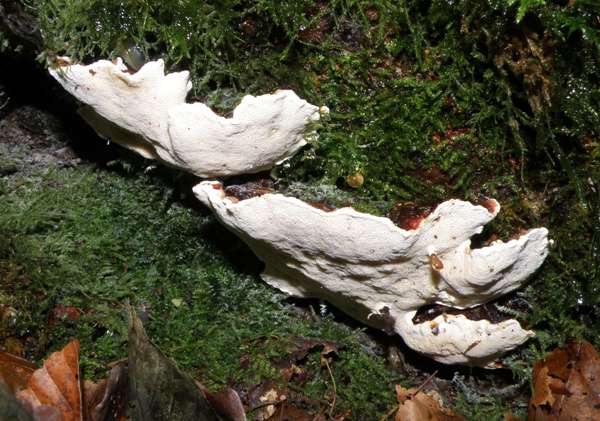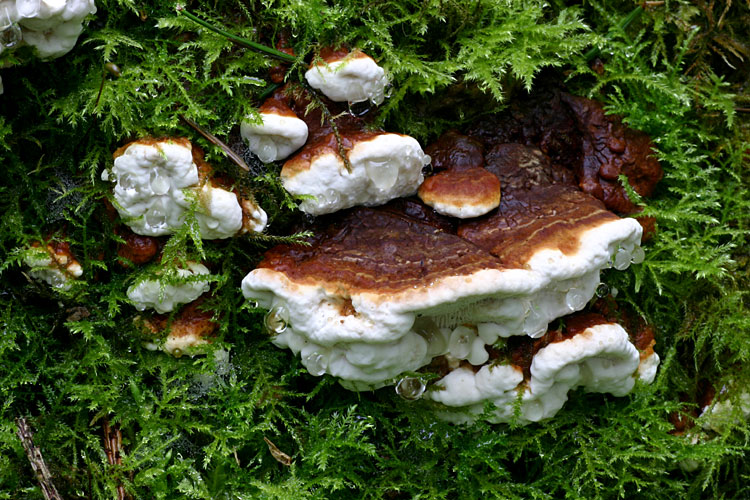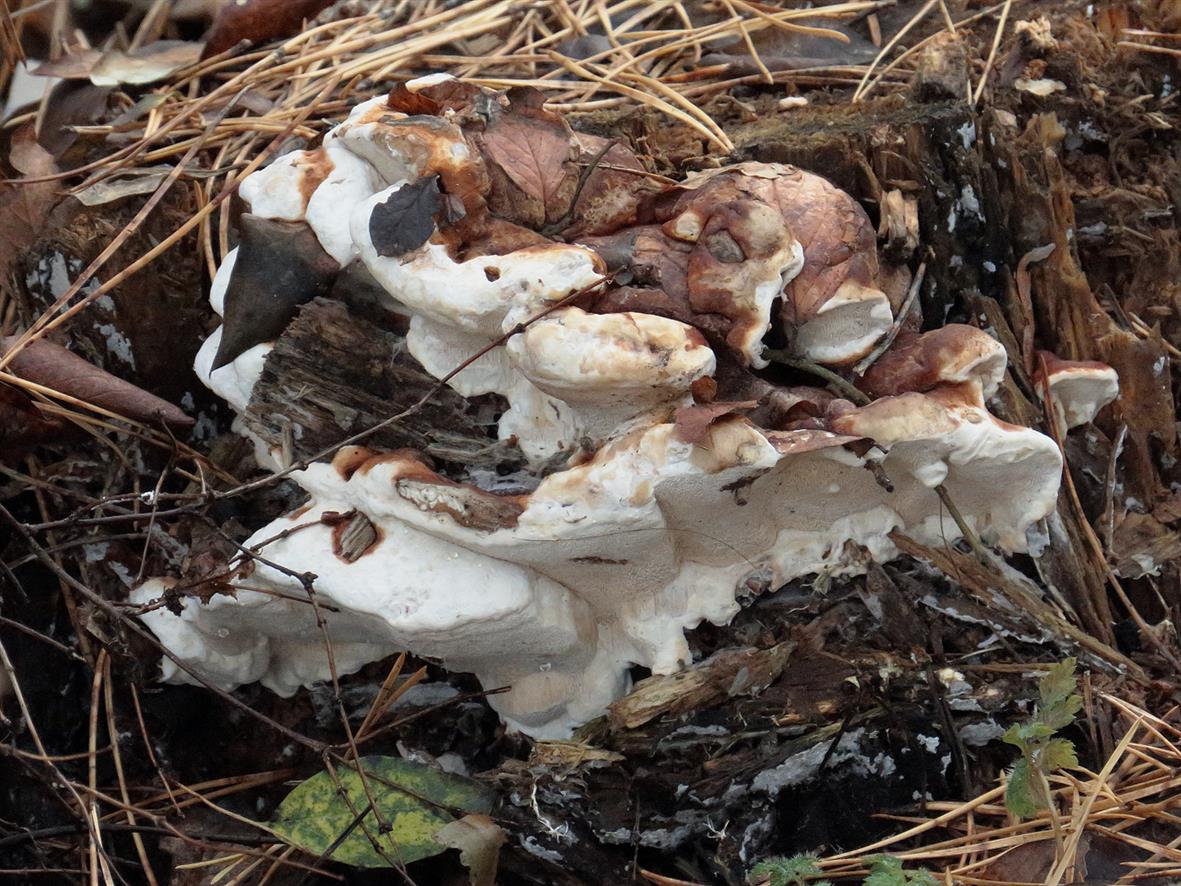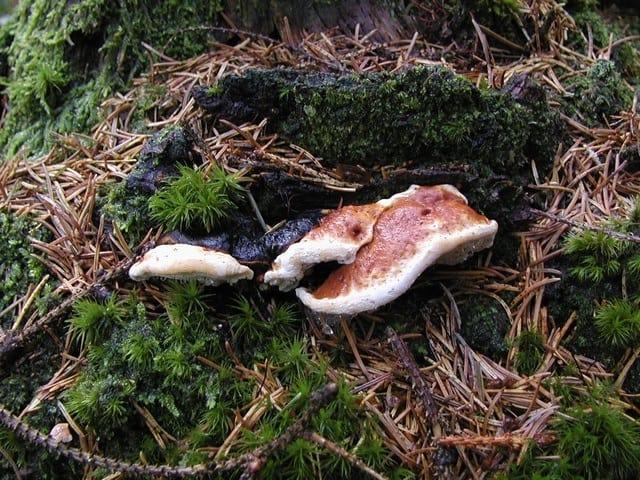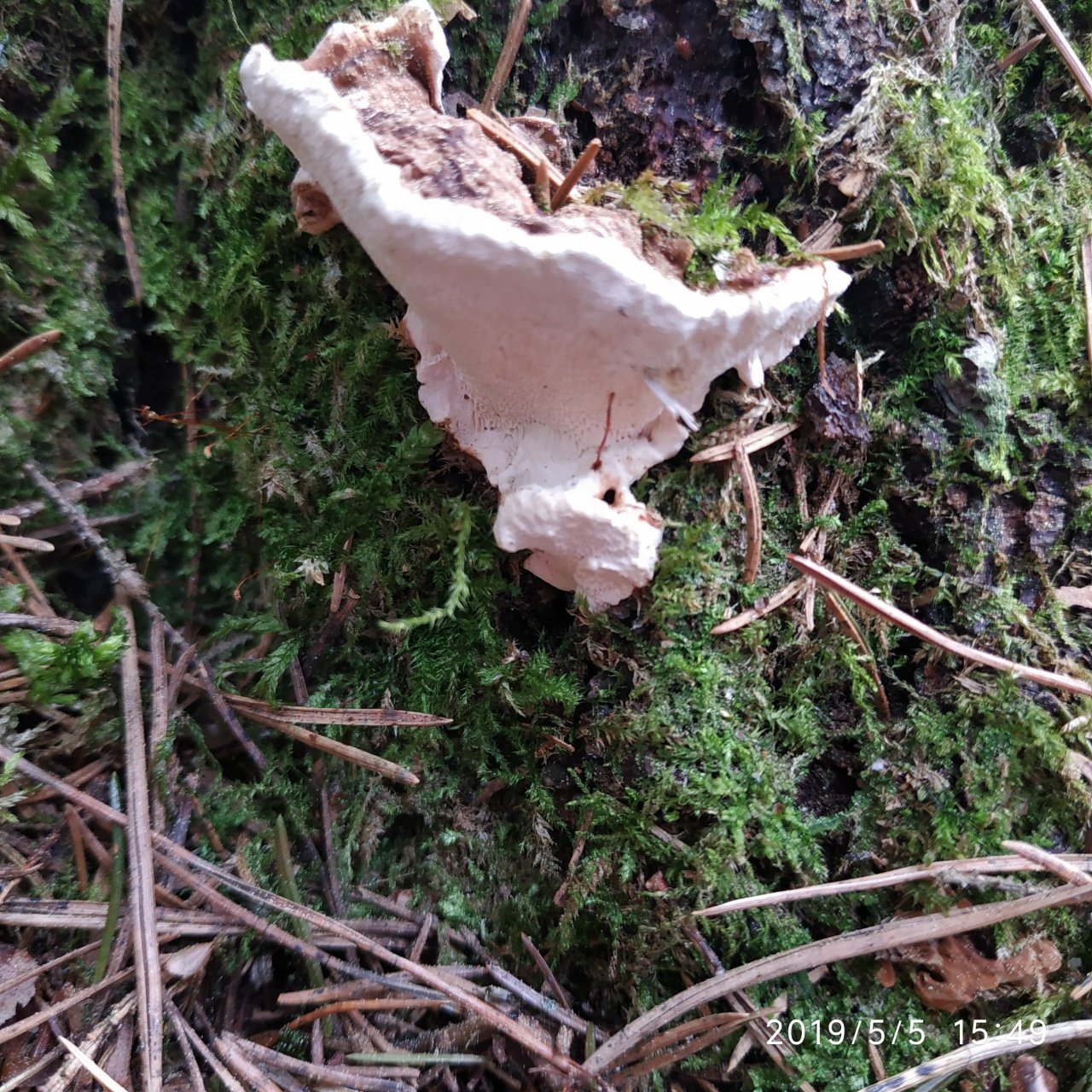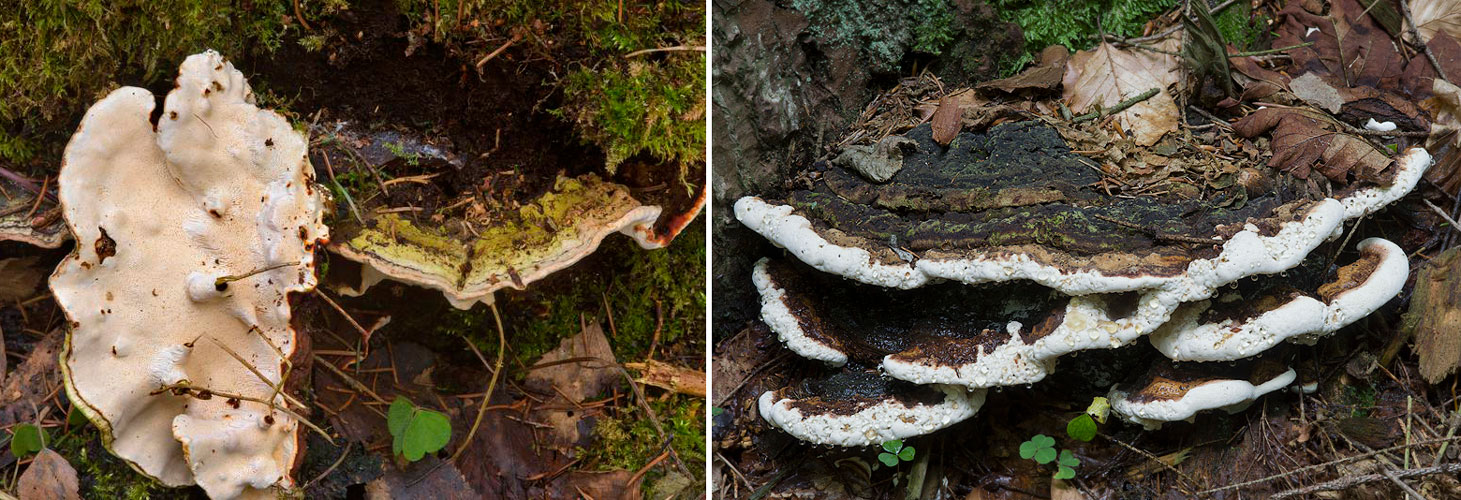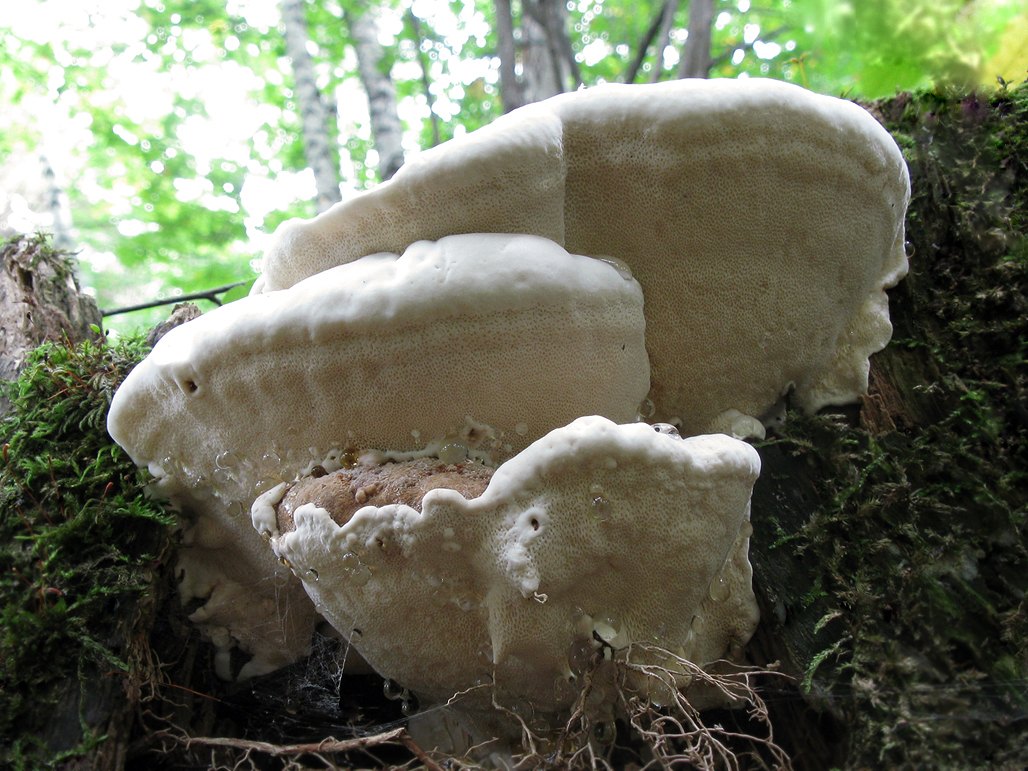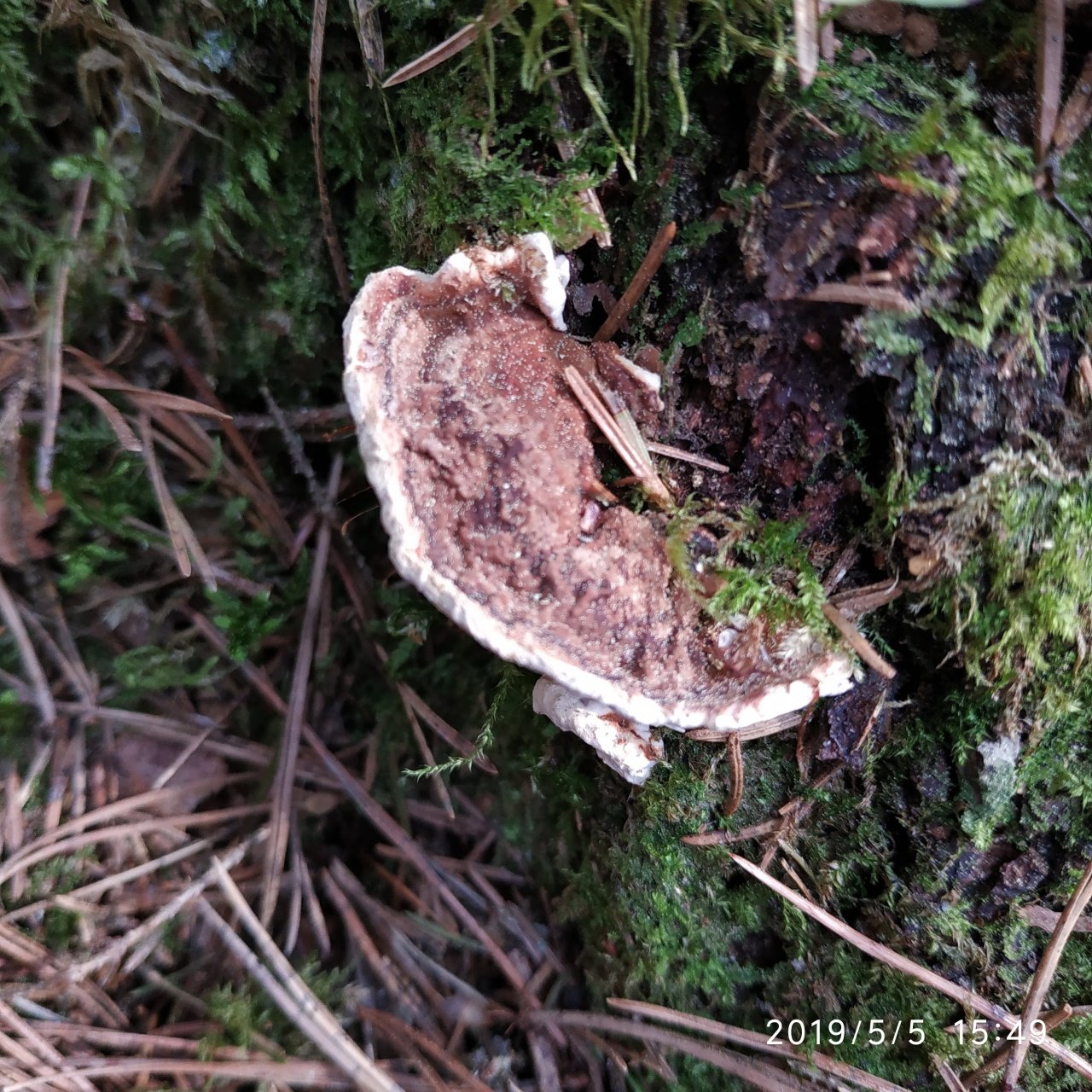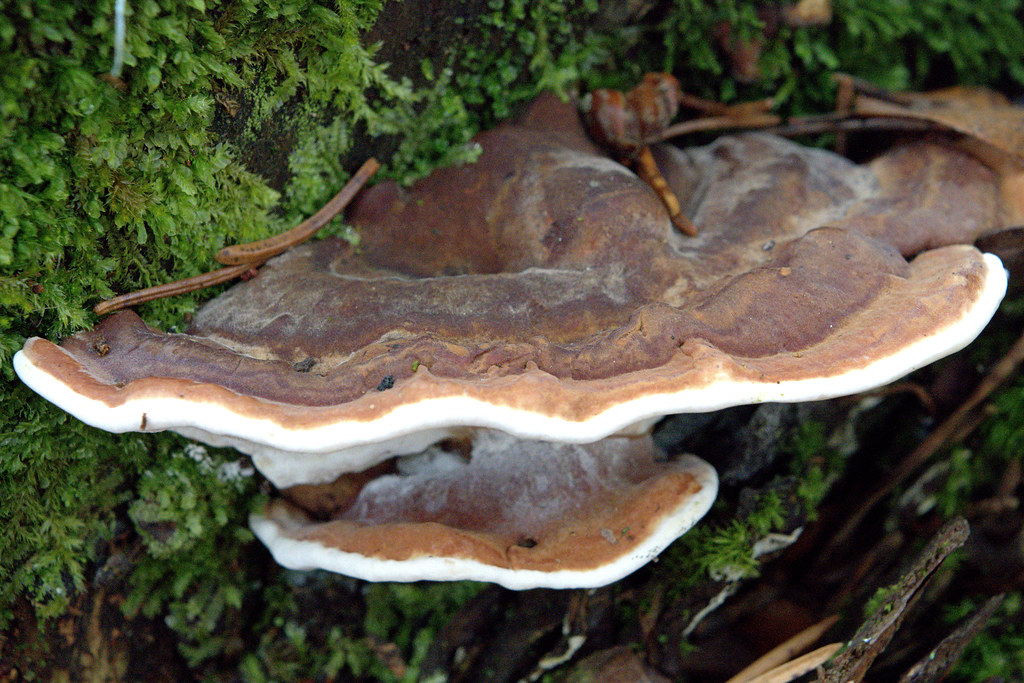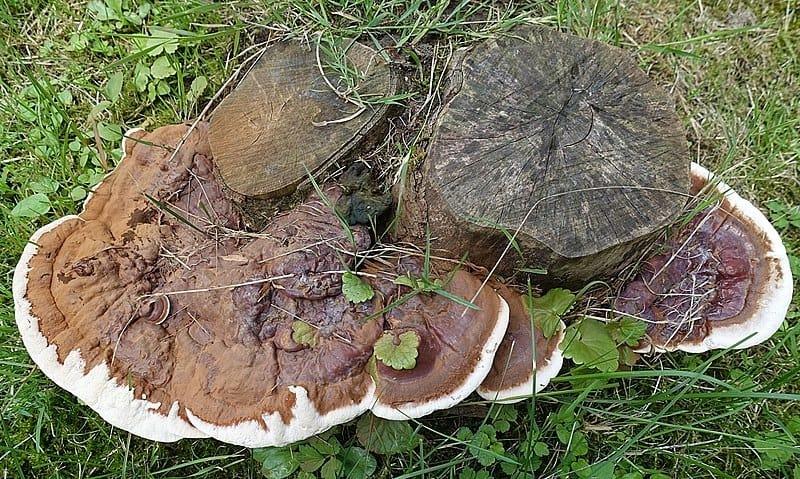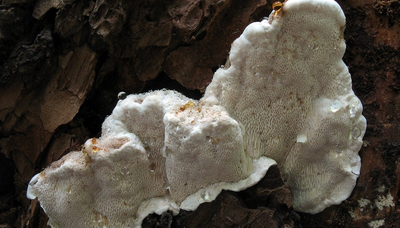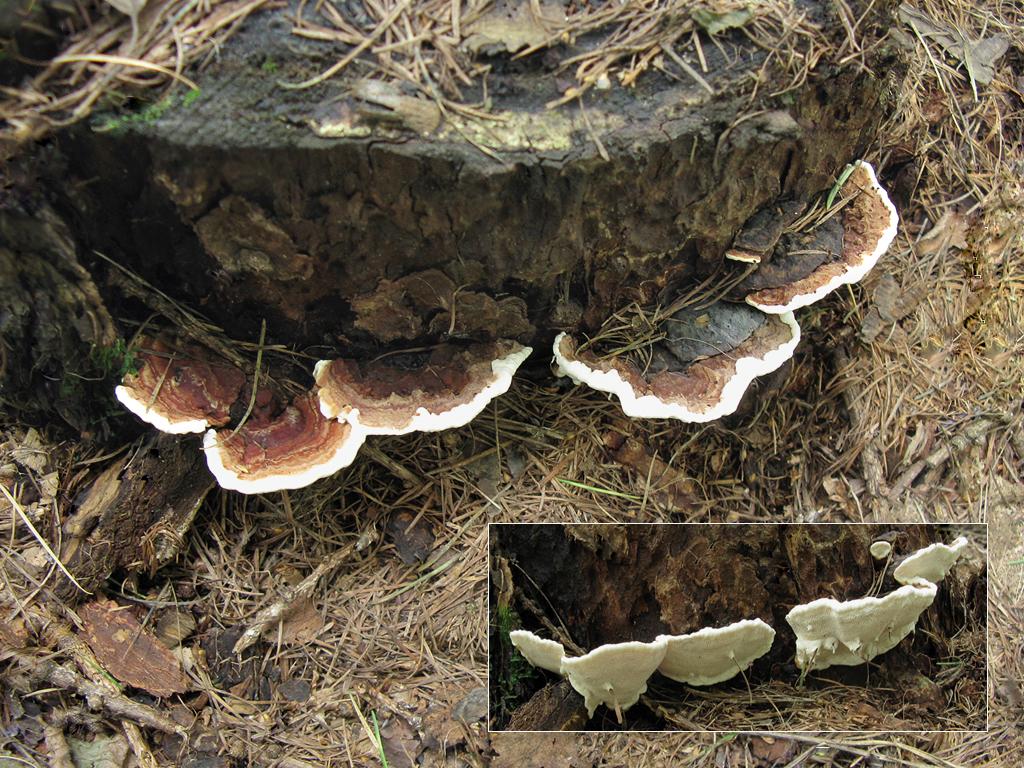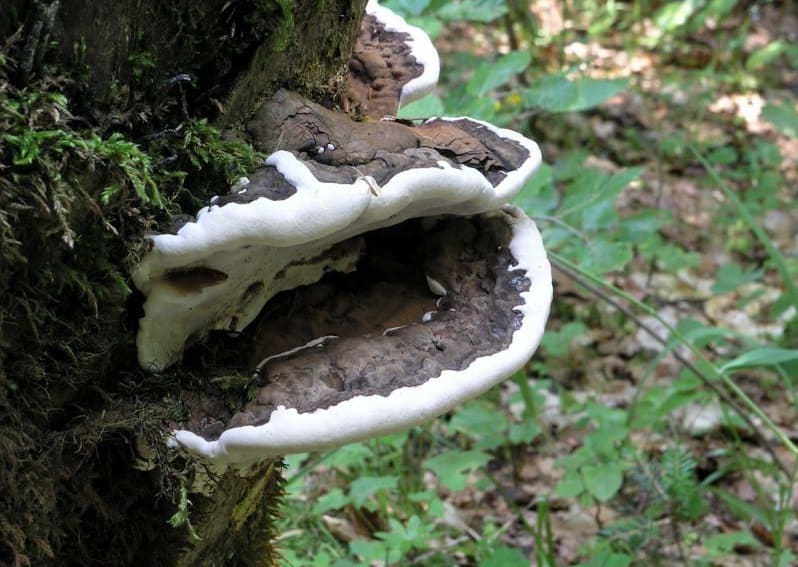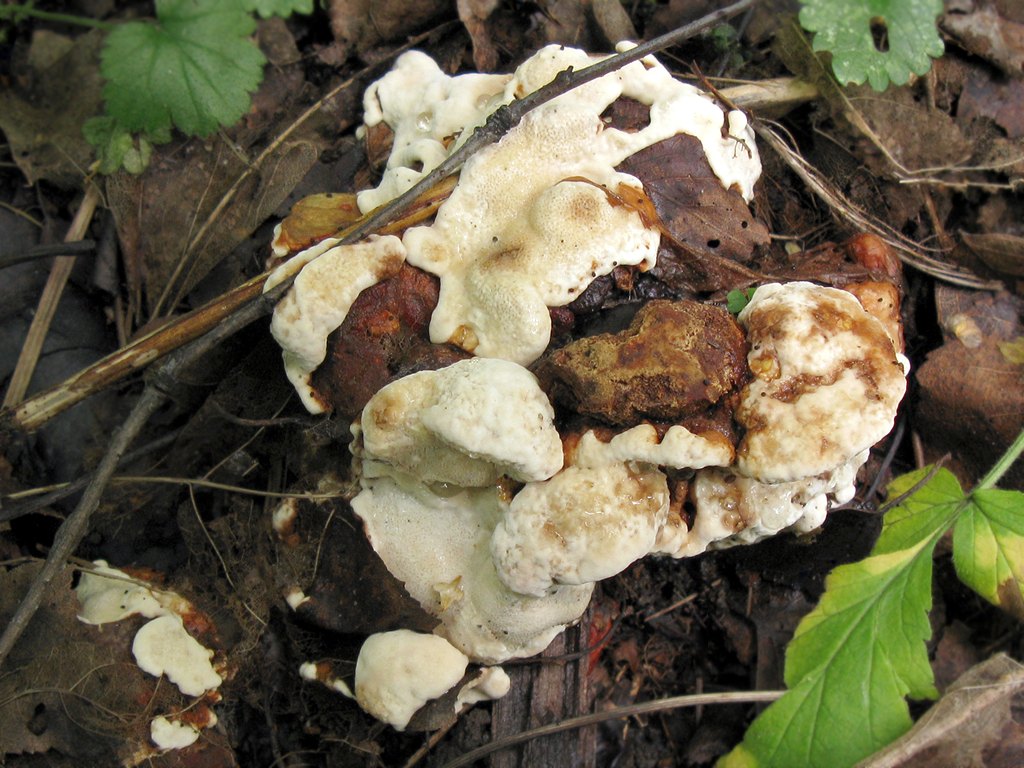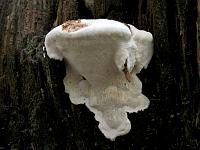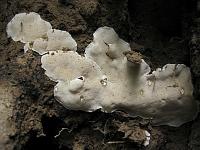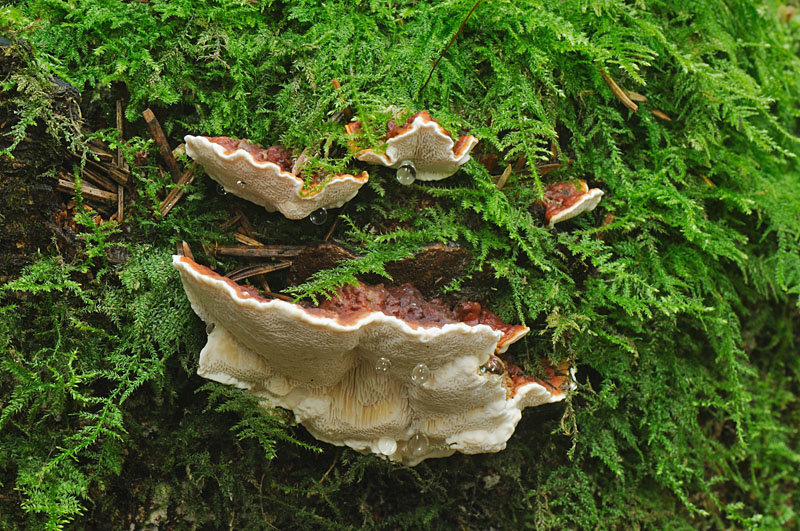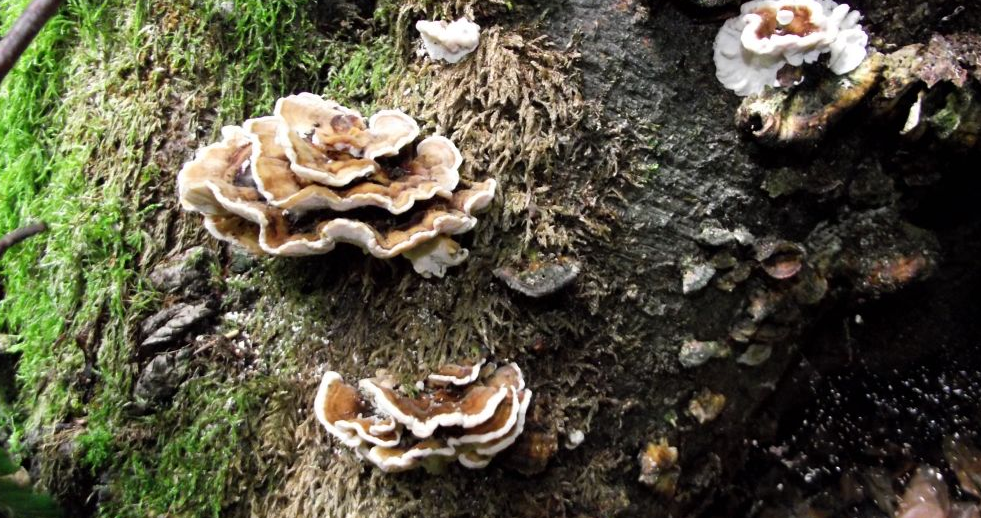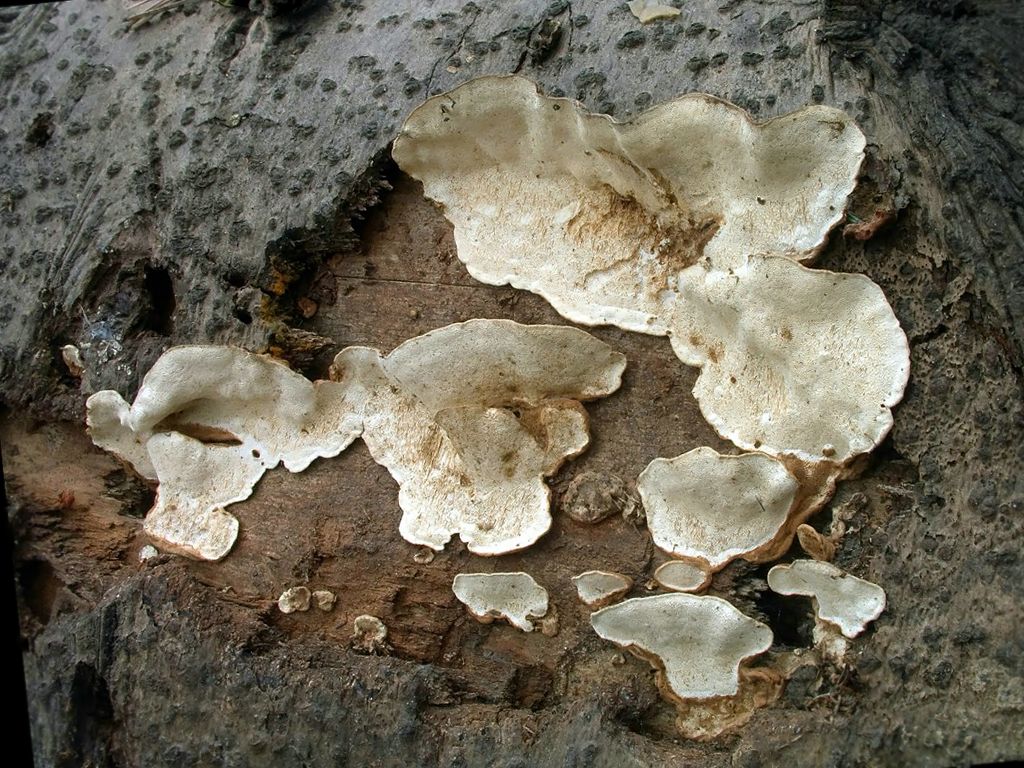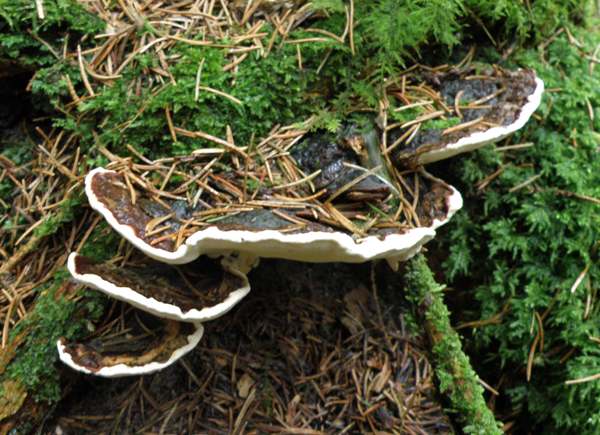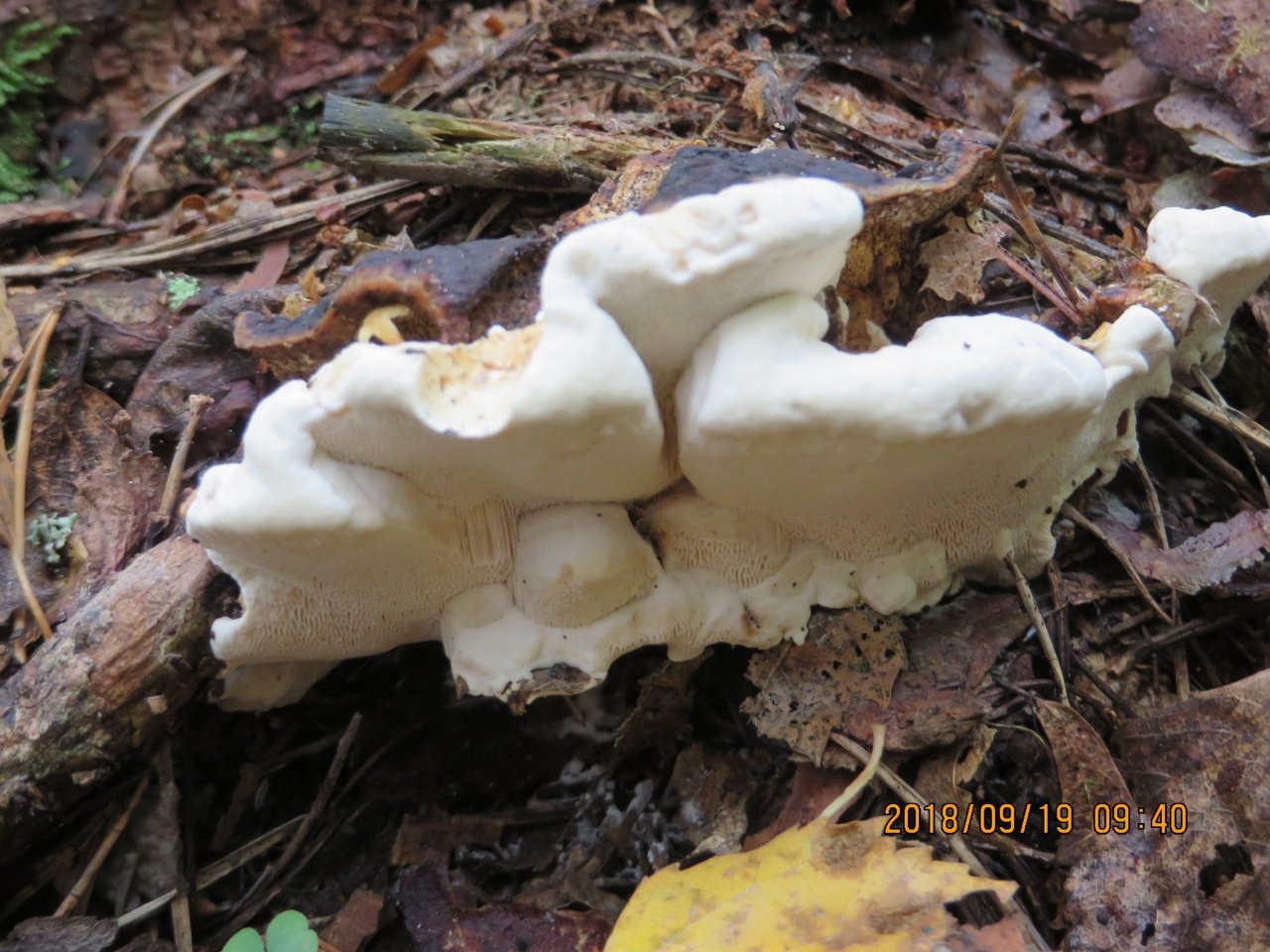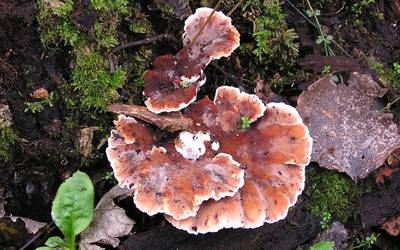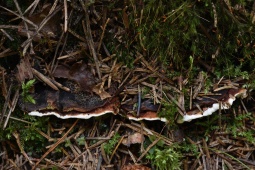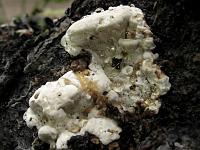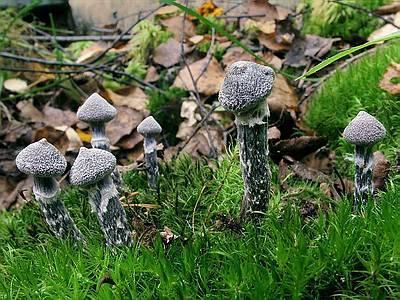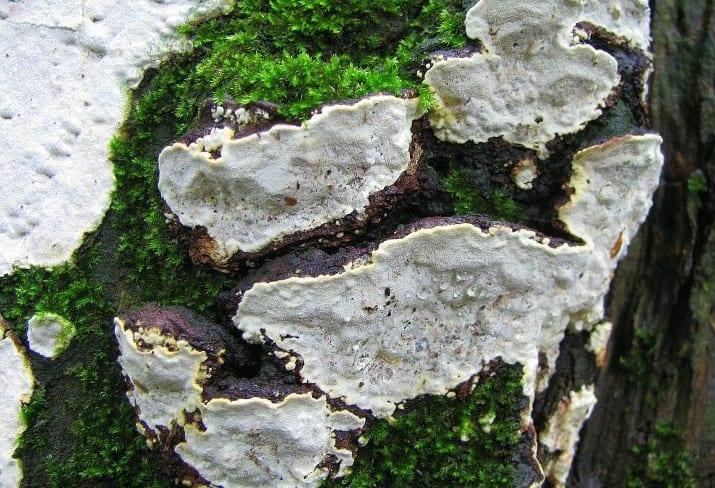Ecology and life cycle
In the summertime, basidiospores, the primary infective propagules, are released. These basidiospores are carried long distances by wind currents. They infect trees (usually conifers) through damage such as freshly cut stumps. Once on the stump the fungus colonizes and moves into the root via mycelium. Heterobasidion annosum moves short distances from the roots of an infected stump through root grafts with other trees. It can also spread through insects that feed on roots.
Since this fungus can not move very far through soil, it relies on tree roots to help it infect neighboring trees. In these roots, it can grow 0.1–2.0 m per year. This results in a spread of the fungus and disease gaps in the forest. These disease gaps are produced when the trees dies and falls, creating gaps in the forest canopy. These gaps affect the moisture and sunlight available, altering the habitats for plants and animals on the forest floor. Spiniger meineckellus, the name for of the asexual stage of this fungus, is produced on stumps when the conditions are moist, and the conidiospores that are produced will be able to live in the soil for up to ten months. The role of conidiospores is unknown in the infection process and is not thought to be important.
Management
Theoretically, a root can be suppressed during all stages of its life cycle. There are three ways of managing Heterobasidion annosum: silvicultural control measures, chemical methods and biological control. Silvicultural control involves planting species with low susceptibility. This could lower the root rot problem and free an infected site from inoculum. A more extreme measure is to remove the inoculum from the infected site. Proper planning and mixture schemes produce a better yield than a pure plantation (i.e. containing only one species). An alternative species could always be used for protection against H. annosum... Chemical methods include prophylactic stump treatment with a solution of urea immediately after the infection. This protects the stump by hydrolysis of the compound by the enzyme urease in the living wood tissue, which results in formation of ammonia and a rise in pH to a level that H. annosum at which mycelia are unable to survive. Biological control is another alternative. Currently, a number of fungal species such as Phlebiopsis gigantea, Bjerkandera adusta and Fomitopsis pinicola have been tested on stumps as competitors and antagonists against H. annosum... However, among these, only Phlebiopsis gigantea shows good results of eliminating H. annosum.
Signs and symptoms of illness
The signs and symptoms of athlete's foot are often considered metro. H. annosum infections cause an abnormal change in the structure in the roots that rises to the end of the tree. More than half of the tree can be killed before any signs appear to the human eye. Basidiocarps can take up to one and a half or even three years to be visible. This infection causes trees to have abnormal needle growth, pale yellow bark, and trees to wilt and die. This root disease usually causes the tree to have a thin crown from ascending and inside out. The trees will eventually die. A landscape sign of scale is rings of dead trees in various stages of decay and death, with the oldest in the center and progressively younger moving outward. White rot fungus found in the roots is a sign of reporting whether the tree has been affected H. annosum... The colors of the bark changes as the stages progress, they go from pale yellow to solid light brown, and finally in its late stage it fades with signature Fomes annosus - a sprinkled strip of black spots. Another sign is the leaking part of the root, which causes a compact mass to form between it and the sand.
Control
In theory, the root can be suppressed during all stages of its life cycle. There are three ways to manage Heterobasidion annosum: forestry control measures, chemical methods and biological control. Forestry control associated plant species with low susceptibility. This could reduce the problem of root rot and free the infected site from grafting material. A more extreme measure is to remove the grafting material from the infected site. Proper planning and mixture schemes produce a better crop than a pure plantation (i.e. containing only one variety). An alternative variety could always be used to protect against H. annosum... Chemical methods immediately include prophylactic treatment of the stump after infection. This protects the stump by hydrolysis of the compound by the enzyme urease in the living wood tissue, which results in the formation of ammonia and an increase in pH to a level that H. annosumin which mycelia are unable to survive. Biological control is another alternative. Nowadays, there are many fungal varieties such as Phlebiopsis gigantea, Bjerkandera adusta and Fomitopsis pinicola have been tested on stumps as competitors and antagonists against H. annosum... However, among them, only Phlebiopsis gigantea shows good elimination results H. annosum.
Heterobasidion insulare
The H. insulare complex comprises seven Heterobasidion species present in Eastern Asia and India. These are primarily saprotrophic decay fungi that are rarely pathogenic. These fungi are found on stumps and logs of are evergreen forest tree species including pines, firs, cedars, and spruces. Some species of this fungal complex can be easily differentiated from H. annosum sensu lato due to the red coloration on the top surface of the fruiting body.
Once considered a single species, theH. insulare complex is now considered to comprise six distinct species based on results of morphological studies, intersterility trials, and genetis. Mating tests have identified four inter-sterility groups: N, T, Y, and Z. The seven species are H. orientale (N-type), H. ecrustosum (T-type), H. insulare sensu typi, H. linzhiense, H. australe, H. amyloideum, H. tibeticum (Z-type).
Symptoms and signs of disease
Symptoms and signs of fungus disease are often found underground. The H. annosum infections cause an abnormal change in structure in the roots that climbs up to the butt of the tree. More than half the tree may be killed before any symptoms appear to the human eye. Basidiocarps can take up to one and a half or even three years to be visible. This infections causes the trees to have abnormal needle growth, pale yellow barks, and the trees to wither and die. This root disease causes typically the tree to have a thin crown from bottom up and inside out. Trees will eventually die. A landscape scale symptom is the rings of dead trees in various stages of decay and death, with the oldest at the center and progressively younger moving outward. The white rot fungus found in the roots is the sign of telling whether the tree has been affected by H. annosum... The bark changes colors as the stages progress, they go from pale yellow, to a crusty light brown, and finally in its advanced stage it turns white with the signature of Fomes annosus - a sprinkled streak of black spots. Another sign is the leaking part of the root that causes a compact mass to form between it and the sand.
Perennial heterobasidion
Heterobasidion perennial - Latin Heterobasidion annosum
In other sources, it is called Root Sponge, Pine Tinder fungus or Root Rot.
Description of the mushroom
External characteristics
The fruit bodies of these perennial mushrooms have an irregular shape and, having no legs, are attached to the wood with one side in a continuous way, as if hugging it. Fruiting bodies reach 15 cm in length and 35 mm in thickness (closer to the place of growth), when grown together they turn into a mushroom mass with a length of about 40 cm.
Root Sponge caps have the shape of shells, are distinguished by a prostrate appearance and have a bent edge. They often grow together. The hats have an uneven surface covered with skin and have a light brown, reddish brown, chestnut or chocolate brown color, which darkens as the mushroom ages up to black. The edges contrast with the base color as they are shaded with yellow.
The fruit body of a young Pine Tinder fungus is filled with flexible cork pulp of white, pale yellow or light ocher color. The next year, it grows stiff and darkens.
The bottom of the hat is formed by layered shiny tubes that grow every year. First, they acquire a white color, after that they become creamy, with a yellowish tinge, when pressed, they turn brown.
The fungus reproduces by white spores.
Growing places
Perennial heterobasidion prefers stumps, the butt of the trunks and the roots of dead and living pines sticking out of the ground, sometimes growing on fir, larch, maple, oak, poplar and even apple trees. It is harvested on the Eurasian and North American continents, where the temperate climate reigns.
Since the mushroom is perennial, it can be found throughout the year.
Edibility
Mushrooms like Korneva sponge are not edible: no one wants to eat cork or wood.
Heterobasidion perennial - Latin Heterobasidion annosum
- Heterobasidion is small pore. It grows on spruce, fir, birch and larch trees and stumps and has smaller tubular pores.
- Heterobasidion is insular. It is found in the Far East on the trunks of fir and deciduous trees.
- Fir heterobasidion. I took a fancy to the Caucasus, where it grows only on fir trees.
- Tinder fungus bordered. It differs in a different shape of the fruiting body - it looks like incrustations of various shapes, as well as larger pores of the hymenophore.
- Tinder fungus is flat. Has a lighter color and large pores. Its tubular layer does not turn brown when pressed.
- Lacquered polypore. It has a varnished crust and larger pores, grows mainly on deciduous trees, but sometimes it takes a fancy to spruce trunks and hemp.
The causative agent, the causes of distribution and the focus of the perennial fungus
Only conifers have the ability to be affected by this fungus. These include spruce, fir, pine or juniper. Undoubtedly, there are exceptions to this rule, because deciduous trees are likely to be affected. In this case, experts distinguish birch, oak, or clear.
It has been established that in the wild there are several so-called morphological forms of these fungi. First of all, they all differ in geographic location. Also, all have a different degree of pathogenicity.
Features of larch disease
The fungus of this specimen is rarely capable of infecting deciduous trees, but such a possibility exists. To a greater extent, this applies to birch, aspen and alder.
Disease of common spruce, fir and pine
The root sponge fungus is dangerous for trees and to a greater extent this applies exclusively to conifers. It is possible to determine such a lesion only due to the presence of the body of the fungus on the tree. As a rule, this process is carried out in an area where the humidity is high.
It is a perennial form with various configurations. In total, it just resembles a hat, which with one of its half is attached to a tree, a stump, and so on. If we talk about the defeat of the spruce mushrooms, then it is attached mainly to the root system.
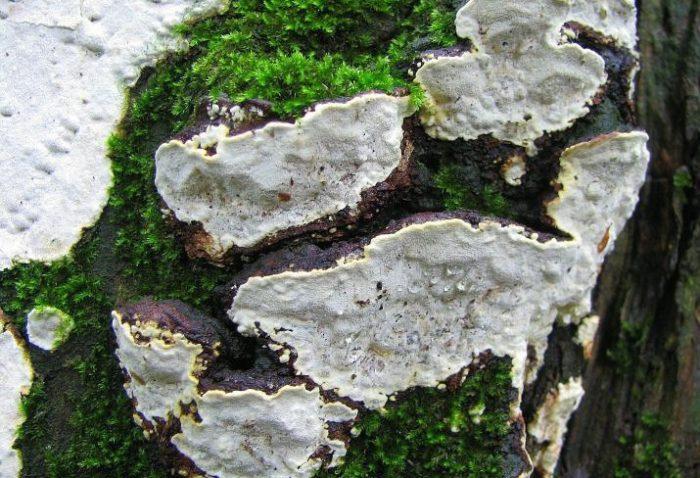 As for the defeat of a pine tree, rot spreads only along the roots and in minimal cases can rise higher. When the initial stage of direct decay sets in, the roots and their wood are impregnated with the so-called resin.It itself becomes glassy, and at the same time acquires a red color. Such a resin has the ability to come to the surface, but over time it all goes away, and the wood at the root acquires a yellow color.
As for the defeat of a pine tree, rot spreads only along the roots and in minimal cases can rise higher. When the initial stage of direct decay sets in, the roots and their wood are impregnated with the so-called resin.It itself becomes glassy, and at the same time acquires a red color. Such a resin has the ability to come to the surface, but over time it all goes away, and the wood at the root acquires a yellow color.
IMPORTANT! Diseased trees are seriously affected by this fungus. This is justified by the fact that their growth decreases, shoots of a shortened type appear, and the needles themselves at the same moment become dimmer and lose their attractiveness.
On pine forests, this fungus clearly expresses the drying out of the plant.
If we talk about the defeat of spruce or fir by this fungus, then direct rot eventually rises to the butt of the trunk. This process can cover a meter or two, and in some situations even affects the entire tree. With this process, rot of the sound and variegated type begins to develop in the roots. The purple color of the wood indicates that this is only the first stage of decay. Over time, the color changes and may already be red or brown. White and oblong spots can be seen on the tree, which is also characterized by black strokes.
The final stage of such rotting is accompanied by voids in the tree, which resemble simple cells. In this case, the wood becomes completely decrepit and finally loses its strength. The tree also depletes an extremely negative odor, which is the same as a mushroom. During the decomposition process, the rot can separate from the healthy part of the tree. Often, such a process is accompanied exclusively at the first stage of the onset of root decay. Fungus lesions are often of an exceptional diffuse or chaotic nature. At first, the shaken trees do not give the slightest idea that they are already affected. Gradually, the first so-called symptoms begin to be observed. This manifests itself in the form of drying out of the tree and a significant reduction in its growth.
IMPORTANT! Root sponge can infect both natural plantings and artificial ones. But this is rare in root pine forests.
As for spruce or fir, trees there at a high level are affected by both natural and artificial samples.
The root-type sponge is a direct disease that is extremely dangerous for coniferous tree species. This is primarily due to the fact that, in the event of damage, a large number of plantations can become infected in a quick period of time. In the future, these trees dry up en masse, and plantings of a different type simply lose their shape, color and attractiveness. Fast drying speaks and the spread of stem-type pests. On the territory of forests and plantations in the Russian Federation, this pest is very common.
Identification
The fruiting bodies of the mushrooms, which are also known as basidiocarps, are whitish around the edges with button-shaped pads, and dark brown on the upper surface. This fruiting body is created from the mycelium, the mass that forms around the plant part of the body of the tree, i.e. that part of the tree without differentiation as stem, leaves, or in this case roots. Basidiocarps are approximately 40 cm in diameter and 3.5 cm in thickness. The lower surface of the fruiting body is made of visible pores that are between 5 mm and 26 mm. Sexual spores are created from basidiocarps called basidiospores. Conidiospores originate in the asexual stage and are produced in conidiophores
Conidiospores and basidiospores are both produced by the fungus, the latter being more important for the infection of conifers
Heterobasidion annosum sensu lato
Heterobasidion annosum sensu lato is a collection of the several species that cause Heterobasidion root disease and butt rot of forest trees and occasionally those in landscape plantings across the Northern Hemisphere. These fungi can be saprotrophic or necrotrophic, colonizing nonliving heartwood or living roots. Numerous tree species have been identified as hosts, but evergreen trees such as pine are most commonly affected. Heterobasidion root disease and butt rot are a serious issues to forest health due to tree mortality, decreased lumber volume and quality, and lessened carbon sequestration. This group of species include some of the most intensively studied forest tree pathogens, becoming the first basidiomycete forest pathogen to have its genome sequenced in 2012.
Heterobasidion annosum sensu lato includes five species, which differ in host preference, genetics, morphology, and geographic range. Sexual mating tests have identified three inter-sterility groups: P, S, and F, named after their chief hosts (pine, spruce, and fir). The five species are H. abietinum (F-type), H. annosum sensu stricto (P-type), H. irregulare (P-type), H. occidentale (S-type), and H. parviporum (S-type). Genetic analysis have demonstrated the North American species, H. irregulare and H. occidentale, are distinct from each other and the European species within their inter-sterility groups.
Ecology and life cycle
In the summertime, basidiospores, mainly infectious propagules, are released. These basidiospores are carried long distances by the current of the wind. They infect trees through damage such as freshly cut stumps. Once on a tree stump, the fungus colonizes and moves to the root through the mycelium. Heterobasion annosum moves short distances from the roots of an infected stump through root cuttings with other trees. It can also spread through insects that feed on the roots.
Since this fungus cannot travel very far through the soil, it relies on the roots of the tree to help it infect nearby trees. In these roots, it can grow 0.1-2.0 m per year. This leads to the spread of the fungus and disease gaps in the forest. These disease gaps are produced when trees die and fall, creating gaps in the forest canopy. These gaps affect moisture and available sunlight, altering habitats for plants and animals on the ground. Spiniger meineckellus, the name of the asexual stage of this fungus, is produced on stumps when conditions are moist, and the conidiospores that are produced will be able to live in soil for a maximum of ten months. The role of conidiospores is unknown in the infection process and is not thought to be important.
Description
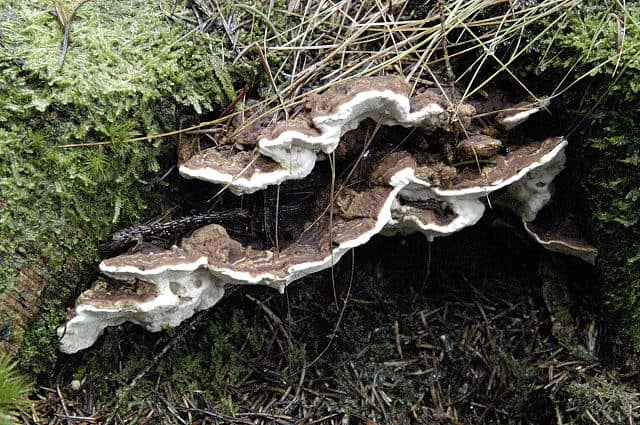 First of all, it is necessary to highlight the second name of the root sponge, which sounds like perennial Heterobasidion. As for the native Latin language, in this case, Heterobasidion annosum.
First of all, it is necessary to highlight the second name of the root sponge, which sounds like perennial Heterobasidion. As for the native Latin language, in this case, Heterobasidion annosum.
The so-called fruiting bodies of such a mushroom are asymmetrical, that is, it is uneven in shape. Its structure does not include a leg. It is for this reason that it is attached to the tree with half of its base. By themselves, the fruit bodies can reach up to 15 cm in size, and its maximum thickness is 4 cm.If the mushroom grows together, it can grow up to 40 cm in length.
The root sponge has a shell-shaped head. The main distinguishing feature is that it has a slight curvature at its edge. Such mushrooms can very often grow together. Also, one cannot but recall the uneven surface that these caps have. It is covered with a skin that is light brown in color.
The edges of the cap provide a contrast from the main color, as they have a shade that is close to yellow. If the body of the fungus is young, then inside it is mainly cork pulp, which is white or slightly pale. Such a body begins to darken with age, and also becomes more rigid, up to a wooden appearance. The bottom of the hat is represented by shiny tubes that exfoliate. Every year there are more and more of them. From the very beginning, they have a white color, then they become more creamy, but when pressed, they begin to turn brown. Breeding method is white spores.
Description
The fruiting bodies of the fungus, which are also known as basidiocarps, are normally brackets which are whitish around the margins and dark brown on the uneven, knobbly upper surface. However they can also take a resupinate form, consisting only of a white crust which corresponds to the underside of the bracket. Basidiocarps are up to about 40 cm in diameter and 3.5 cm thick. The fertile surface of the fruiting body is white, easily bruising brown, and has barely visible pores, with 3-4 per mm. The flesh, which has a strong fungus smell, is elastic when young but becomes woody when older.
Sexual spores called basidiospores are created in the fertile layer on the lower surface of the basidiocarps, whilst conidiospores occur in the asexual stage and are produced on microscopic "conidiophores" which erupt through the surface of the host tree. Conidiospores and basidiospores are both produced by this fungus, the latter being more important for infecting the conifers.
Preventive control measures and methods of treatment of plantings
 In order to protect your plantings, it is necessary to resort to the use of preventive measures. Potential protection measures include:
In order to protect your plantings, it is necessary to resort to the use of preventive measures. Potential protection measures include:
you need to monitor them and carefully evaluate them for new formations of a negative type;
if you see that the plant is affected, then it is worth eliminating it so that the disease does not spread to other trees;
plantings are best done so that they include both deciduous and coniferous trees
Diversity is important;
the material for planting must be used exclusively of high quality, because the likelihood of the plant's resistance to negative factors and root sponges depends on this;
when planting, it is necessary to add an element such as a foundation to the ground. It should also be introduced into the soil during sanitary felling.

